THE GARDENA HIGH SCHOOL ART COLLECTION IS ON VIEW ONCE AGAIN
This story was featured in the October 2019 issue of Southwest Art magazine. Get the Southwest Art October 2019 print issue or digital download now–then subscribe to Southwest Art and never miss another story.
One hundred years ago, in 1919, an extraordinary art collection was born. At Gardena High School in Gardena, CA, just south of Los Angeles, the senior class gifted the school with an original landscape painting by Ralph Davison Miller, and they started an annual tradition. For nearly 40 years, until 1956, each senior class purchased—with funds raised through school plays and other community-oriented projects—one or two artworks as class gifts.
The Gardena High School Art Collection is widely acknowledged as one of the country’s outstanding collections of California Impressionism, not to mention a leading exemplar of a high-school art collection. In some 70 artworks, it traces the history of Southern California art in the early 20th century, when plein-air painting and the Arts and Crafts Movement were flourishing. Among the many prominent artists in the collection are Edgar Payne, Hanson Puthuff, William Wendt, Franz Bischoff, Maurice Braun, Armin Hansen, Jessie Arms Botke, Maynard Dixon, and Marion Wachtel.
When Gardena High School moved to a new campus in 1956, the long tradition sadly came to a close. Many of the paintings in the collection were temporarily hung in hallways, offices, and the library; however, the gallery space allotted in the new building was too small, and the works eventually ended up in storage, gradually forgotten by students and administrators alike.
Now the collection is on view for the first time in decades in the exhibition Gifted: Collecting the Art of California at Gardena High School, 1919-1956. It is on view through October 19 at the Hilbert Museum of California Art in Orange, CA; from January 24 through June 28, 2020, at the Fresno Art Museum; and from July 18 through November 29, 2020, at the Oceanside Museum of Art. It is accompanied by a book of the same title. The following text by exhibition curator Susan M. Anderson—highlighting some of the collection’s top-notch artists and artworks—is excerpted with permission.
Rockbound
BY EDGAR PAYNE
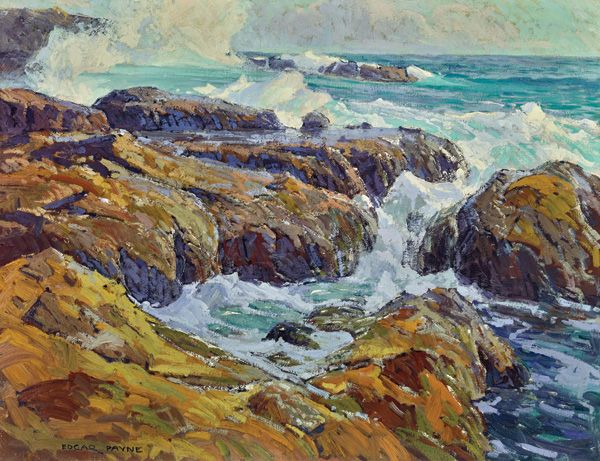
EDGAR PAYNE, ROCKBOUND, C. 1921, OIL, 31 X 40.
Edgar Payne achieved great fame during his lifetime despite being essentially self-taught, after six months of study at the Art Institute of Chicago. Much of his knowledge about plein-air painting and its vivid portrayal of color and light came from his work as a scene painter for early Hollywood films. Payne was the founding president of the Laguna Beach Art Association in 1918, and was intimately associated with the then remote art colony.
ROCKBOUND is one of few extant large-scale seascapes by the artist painted in the environs of Laguna Beach. Like the seascape ETERNAL SURGE in the collection of Laguna Art Museum, ROCKBOUND was most likely based on plein-air sketches Payne made at Coward’s Cove, just east of the Twin Points promontories in North Laguna, and completed in his studio.
In his influential primer, Composition of Outdoor Painting, published in 1941, Payne recommended focusing on breaking waves and spray as a point of interest in marines. As seen in ROCKBOUND, he used warm colors in the rocks to unify and balance the cool greens and blues of the sea. He wrote that a “warm foundation” kept the composition from appearing cold. Here water pools in and glistens over the tide pools lit by the bright midday sun. The dynamic composition is designed to lead our eye in an s-curve from the glistening rocks on the lower right, to the waves and spray on the left, and finally to the open sea.
Cranes Under a Giant Fern
BY JESSIE ARMS BOTKE
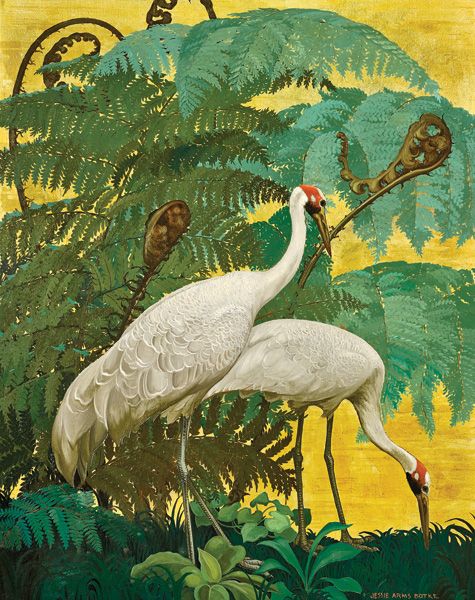
JESSIE ARMS BOTKE, CRANES UNDER A GIANT FERN, C. 1943, OIL/GOLD LEAF, 40 X 32.
Jessie Arms Botke was celebrated for her stylized depictions of exotic birds in lush gardens with backgrounds of 22-karat gold leaf. Botke had studied with and worked for Albert Herter, son of the founder of the leading decorating firm in the United States during the late nineteenth century. Herter Brothers created luxurious, cosmopolitan environments now recognized within the context of the international Arts and Crafts design movement.
Through her work for Herter Looms preparing tapestry cartoons, Botke discovered that birds, inspired by Japanese screens (byobu) of the Edo period (1615-1868) were her forte. Such screens, featuring birds in spare garden settings with gold leaf backgrounds, were an important feature in the sacred settings of Shinto and Buddhist temples. Later, screens featuring cranes were often used during the births of high-ranking members of the aristocracy.
Botke and her husband, Cornelis, were living in Santa Paula at the time of the 1943 Purchase Prize Exhibit. The painting may have come from a show at the Biltmore Art Gallery in Los Angeles, where the couple exhibited together around this time. In 1954, they completed a 6 by 26-foot mural of birds for the Oaks Hotel in Ojai, California (now in The Irvine Museum Collection at UC Irvine), that has echoes of the GHS painting. Ironically, the Japanese community was absent from the high school and city of Gardena at the time of this selection, as they had been sent to relocation camps in 1942 after America’s entrance into World War II.
On the Road to San Gabriel
by Jean Mannheim
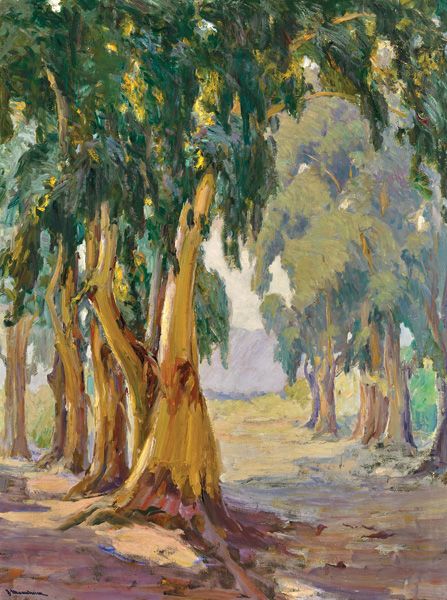
JEAN MANNHEIM, ON THE ROAD TO SAN GABRIEL, C. 1920, OIL, 48 X 36.
Jean Mannheim moved to Los Angeles and built a craftsman studio-home on the Arroyo Seco in 1908. Beginning around 1906, Mannheim had taught at the Brangwyn School of Art in London for a year or so, indicating that he was sympathetic to the Arts and Crafts ethos. Frank Brangwyn had been a protégé of William Morris and prepared designs for many aspects of Morris’s Arts and Crafts output.
ON THE ROAD TO SAN GABRIEL depicts a quiet country road winding through a eucalyptus allée. Mannheim contrasts the soft abstract treatment of the sunlight and shadow with the painterly texture of the trees’ peeling trunks and jumbled masses of bright green and blue leaves. The bright Southern California light seemingly obliterates everything that lies in its path, including the trees on the other side of the road. In the far distance is the atmospheric purple of the San Gabriel Mountains.
Wild yet accessible, this rugged area north of Mannheim’s home in the Arroyo Seco was a favorite painting spot for artists. Mannheim made a series of studies and paintings of roads leading through similar stands of eucalyptus against a mountain backdrop. ON THE ROAD TO SAN GABRIEL, like many of his small studies, is loosely painted and has the same feeling of being completed in one sitting en plein air.
Along the Arroyo Seco
BY WILLIAM WENDT
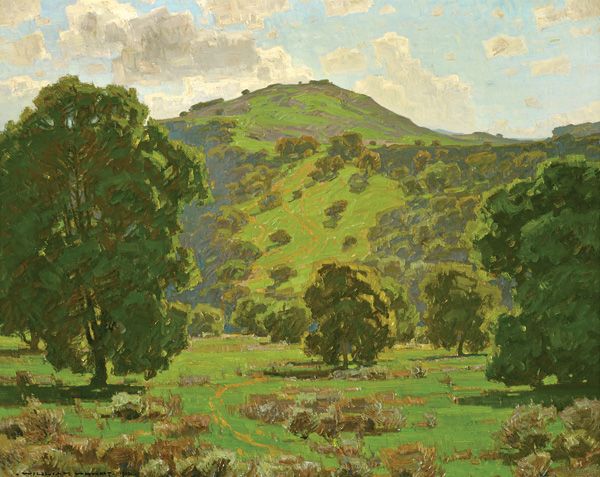
WILLIAM WENDT, ALONG THE ARROYO SECO, 1912, OIL, 40 X 50.
William and Julia Bracken Wendt’s home and furnishings, as well as their lifestyle and beliefs, reflected an integrated attitude toward art and life that was in sync with the Arts and Crafts aesthetic. Their studio home, like the homes of many of the plein-air artists, was a simple bungalow, a common architectural style of the Arts and Crafts Movement, and symbolic of the “back to basics” lifestyle possible in California.
ALONG THE ARROYO SECO is an exemplary Wendt painting, full of green, the color of hope and of spring. A sense of new beginnings and divine abundance is implicit in the artist’s work—making it a quintessential expression of California’s bounty. The high horizon created by the canyons lends both monumentality and intimacy to Wendt’s paintings. His landscapes express a state of sustained immersion in nature that produces a quiet emotion akin to awe, articulating his deeply held beliefs about God and nature.
Wendt’s composition in ALONG THE ARROYO SECO is rhythmic and dynamic. He leads our gaze to the peak of the mountain by incorporating a zigzagging line through the center of the painting in a way that encompasses the whole composition—as if seen by God’s omniscient eye. The landscape is bathed in the strong bright light of Southern California. Foreground, middle ground, and background are all treated with tremendous depth of field. However, our gaze continually returns to the small tree placed slightly below center in the painting, around which the composition slowly turns.
Men of the Red Earth
BY MAYNARD DIXON
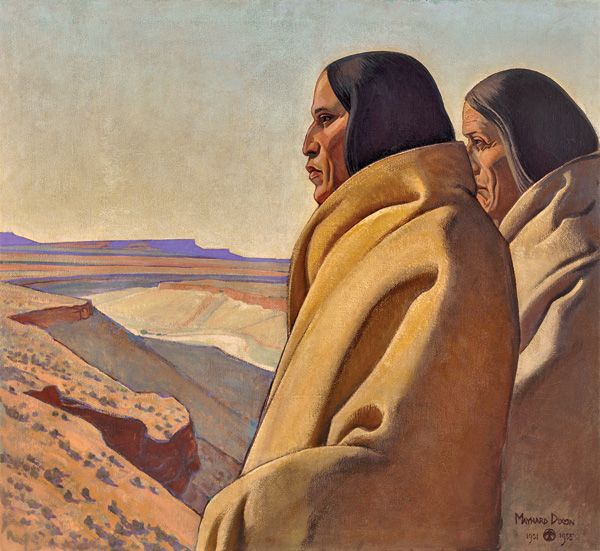
MAYNARD DIXON, MEN OF THE RED EARTH, 1931-32, OIL, 36 X 41.
Maynard Dixon was a member of the informal Garvanza circle of artists at the turn of the twentieth century. Situated on a plateau in the valley of the Arroyo Seco, Garvanza drew numerous painters as well as Charles Lummis, founder of the California Landmarks Club. Dixon was a close friend of Lummis, who in 1900 gave the artist a letter of introduction to the Pueblo Indians, starting him on his long career as a painter of the American West and its inhabitants. At the time, Dixon was an illustrator, and would have a spell in New York working for numerous publications until about 1912.
By the 1920s, Dixon had begun developing a stark, rhythmic approach to painting the desert, exposing the architectural forms and Cubist angles of the landscape. The pared-back aesthetic worked well in rendering the harsh Southwestern desert and its indomitable denizens. Dixon and the photographer Dorothea Lange, who he had married in 1920, traveled throughout the arid lands seeking inspiration for their art.
MEN OF THE RED EARTH is an example of Dixon’s mature work. The iconic image of Native Americans looking out over a vast expanse of desert has been simplified to its barest elements. He juxtaposes flat, two-dimensional striations of color in the distant landscape with the tangible, three-dimensional forms of the two men. He emphasizes stoicism and solemn dignity in the men, while in the land he underscores the ordered, abstract structure underlying our perceived reality, endowing the whole with a sense of the eternal.
This story was featured in the October 2019 issue of Southwest Art magazine. Get the Southwest Art October 2019 print issue or digital download now–then subscribe to Southwest Art and never miss another story.
MORE RESOURCES FOR ART COLLECTORS & ENTHUSIASTS
• Subscribe to Southwest Art magazine
• Learn how to paint & how to draw with downloads, books, videos & more from North Light Shop
• Sign up for your Southwest Art email newsletter & download a FREE ebook






The elementary school in rural Idaho I attended also contained a collection of art. Originally the school was also the high school and the students also purchased works by Edgar Payne and Jessie Arms Botke as well as some regional painters. This article brought back fond memories of that.